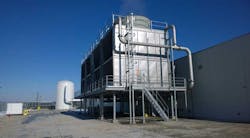ASHRAE Begins 45-Day Review for New Data Center Cooling Standard
The leading standards group for cooling professionals has begun a 45-day review period for its new energy efficiency standard for data center cooling, known as ASHRAE Standard 90.4.
Data center executives have expressed concern that the new rules on cooling could create expensive headaches for data center operators. Officials from ASHRAE say they are working with key players in the data center sector, and are eager to ensure that the standards reflect best practices. But it’s clear that bruised feelings remain from ASHRAE’s last foray into data center standards, and early versions of the proposed Standard 90.4 for data centers have raised alarms among some in the industry.
The updated draft offers several compliance paths, including using Power Usage Effectiveness (PUE), the leading metric for energy efficiency in data centers. Standard 90.4 lists maximum PUEs of 1.30 in the coolest climates, ranging up to 1.61 in the warmer areas. The most efficient data centers operate at PUEs between 1.08 and 1.20, with the industry standard for existing facilities estimated at about 1.70 to 1.80.
The standard applies to new data centers, upgrades to existing data centers, and “modifications to systems and equipment in existing Data Centers or portions thereof.” The rules do not apply to telecom exchanges or IT equipment. ASHRAE notes that use of water in cooling is outside the scope of the Standard 90.4 document.
How To Review the Document
To access and review the 66-page draft document, go to the ASHRAE public review database and hit the “click here” button. That brings you to a page with a lengthy list of standards documents for public review. Scroll down the page and find the header titled “Expand/Collapse 45-Day Public Review Period from September 4, 2015 to October 19, 2015.” The list beneath that heading includes a link for “BSR/ASHRAE Standard 90.4P Energy Standard for Data Centers and Telecommunications Buildings (Second Public Review Draft).” Click this link to download the draft of Standard 90.4.
Comments must follow ASHRAE’s guidelines, which are outlined in a PDF document. The announcement (PDF here) was issued the Friday before Labor Day, and some mailing list members were not notified until Tuesday (Sept. 8). The 45-day comment period concludes on Oct. 19
For a full review of the background of the ASHRAE standards and the data center industry, see our article: ASHRAE Standards: Where Cooling and Controversy Collide.
ASHRAE develops standards for heating, ventilation, air conditioning and refrigeration that provide guidance for local officials in towns and cities across America. These inspection and code enforcement officials – known broadly as “authorities having jurisdiction” or AHJs – wield tremendous influence over construction projects.
“It’s alarming how many companies in this industry are not aware of this,” said Chris Crosby, CEO of Compass Datacenters. “There’s no real call to arms.”
As we noted in our initial article in July:
The upcoming final review period for Standard 90.4 represents an opportunity for both ASHRAE and the data center industry. For the industry, it’s an opportunity to better engage with a body that will be updating the standards for local data center construction for years to come. For ASHRAE, it’s an opportunity to build trust and forge a better relationship with data center thought leaders.
About the Author



